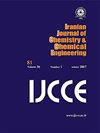响应面法优化Ni/HY催化剂上煤油芳构化反应
IF 1.3
4区 工程技术
Q4 CHEMISTRY, MULTIDISCIPLINARY
Iranian Journal of Chemistry & Chemical Engineering-international English Edition
Pub Date : 2021-11-03
DOI:10.30492/IJCCE.2021.529645.4709
引用次数: 0
摘要
本文制备了几种Ni/Y催化剂,用于煤油芳构化。将Y型沸石的Na+阳离子与NH4+交换,然后采用沉淀-沉积法合成Ni/HY催化剂。采用XRD、EDX和BET对样品的性质进行了表征。此外,采用响应面法结合三因素中心复合设计对Ni/HY催化剂上的反应条件进行了优化。三个自变量是:催化剂的Ni含量、反应时间和温度。以芳香产率作为响应进行分析,以考察这些自变量的重要性。数值优化结果表明,在负载ni 5%、温度450℃、反应时间120min的条件下,芳烃收率为55.74%。这与在此条件下预测的芳香族含量(52.62%)一致。相关系数(R2= 0.989)、均方根误差(RMSE = 0.77)、预测标准误差(SEP = 1.82)均为可接受值。这些低值证实了该模型在预测适当反应方面的充分性和统计意义。本文章由计算机程序翻译,如有差异,请以英文原文为准。
Optimization of Kerosene Aromatization over Ni/HY Catalysts using Response Surface Methodology
In this paper, several Ni/Y catalysts were prepared to perform kerosene aromatization. The Na+ cation of Y zeolite was exchanged with NH4+, and then Ni/HY catalysts were synthesized through the precipitation-deposition method. Properties of the samples were characterized by XRD, EDX, and BET. In addition, the Response Surface Method in combination with a three-factor Central Composite Design was employed to optimize the conditions of the reaction over Ni/HY catalysts. The three independent variables were: Ni content of the catalysts, reaction time, and temperature. Analysis of aromatic yield as the response was performed to survey the importance of these independent variables. Results of numerical optimization revealed that maximum operation conditions were 5%Ni-loading at a temperature 450oC and a reaction time of 120min, in which aromatic yield was 55.74%. This was in agreement with the predicted aromatic content (52.62%) in this condition. Acceptable value for correlation coefficient (R2= 0.989), root mean square error (RMSE = 0.77), and standard error of prediction (SEP = 1.82) was obtained. These low values confirmed the adequacy and statistical significance of the model to predict an adequate response.
求助全文
通过发布文献求助,成功后即可免费获取论文全文。
去求助
来源期刊

Iranian Journal of Chemistry & Chemical Engineering-international English Edition
CHEMISTRY, MULTIDISCIPLINARY-ENGINEERING, CHEMICAL
CiteScore
2.80
自引率
22.20%
发文量
0
审稿时长
6-12 weeks
期刊介绍:
The aim of the Iranian Journal of Chemistry and Chemical Engineering is to foster the growth of educational, scientific and Industrial Research activities among chemists and chemical engineers and to provide a medium for mutual communication and relations between Iranian academia and the industry on the one hand, and the world the scientific community on the other.
 求助内容:
求助内容: 应助结果提醒方式:
应助结果提醒方式:


